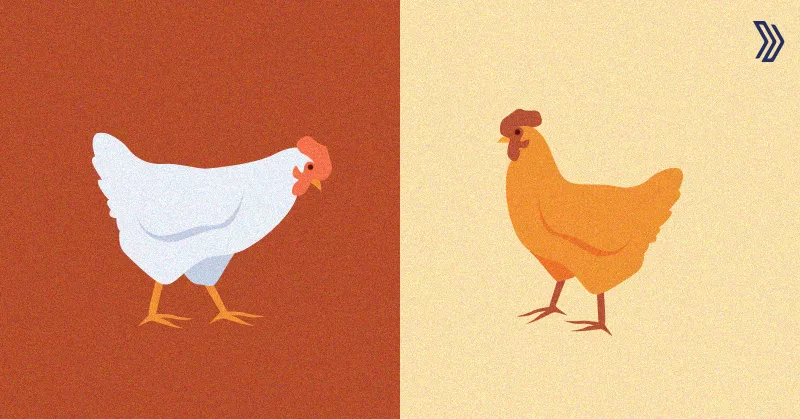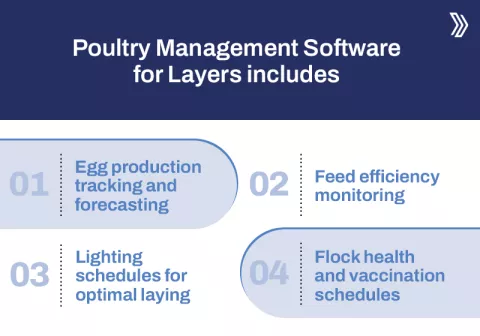In this detailed blog, we'll explore the distinctions between broiler and layer chickens, the differences in their characteristics, and how modern poultry management software is revolutionizing both broiler and layer operations.
Published 04 Jul 2024
In this detailed blog, we'll explore the distinctions between broiler and layer chickens, the differences in their characteristics, and how modern poultry management software is revolutionizing both broiler and layer operations.

When we are discussing poultry farming, two main types of chickens dominate the industry: broiler chickens and layer chickens.
While both are members of the same species, they serve different purposes.
In this detailed blog, we'll explore the distinctions between broiler and layer chickens, the differences in their characteristics, and how modern poultry management software is revolutionizing both broiler and layer operations.
Broiler chickens, also known as broilers, are specifically made for meat production. These birds are the result of careful selection to maximize growth rate and meat yield.
1. Rapid growth: Broilers reach market weight in just 6-8 weeks.
2. Efficient feed conversion: They require less feed to produce more meat.
3. Large breast muscles: Bred to meet consumer demand for white meat
The broiler chicken industry has seen a lot of advancement in recent times. One such advancement is the adoption of specialized Broiler management poultry software that helps farmers optimize their broiler operations.
Modern broiler farms are adopting advanced software solutions to enhance productivity and efficiency. These systems can help monitor and control various aspects of broiler production, including:

By leveraging data-driven insights, farmers can make informed decisions to improve bird health, reduce costs, and maximize meat yield.
Layer chickens, as the name suggests, are specifically for egg production.
These chickens and laying eggs go hand in hand, as they're selected to produce a high number of eggs throughout their productive life. Layer hens are the backbone of the egg industry
1. High egg production: Can lay up to 300 eggs per year.
2. Longer productive lifespan: Typically lay eggs for 1-2 years.
3. Smaller body size: Energy is directed towards egg production rather than meat.
Egg-laying chickens have been selectively used to increase the overall production efficiency. This has led to a steady increase in global egg availability, making them a protein source for many populations.
Layer operations also benefit significantly from specialized Layer farm software solutions. These systems can help manage:

By implementing such software, layer farms can optimize their operations, leading to increased egg production, improved bird welfare, and better resource management.
While both broiler and layer chickens serve essential roles in agriculture, their differences are significant. Let's examine some key areas of comparison:
Broiler chickens are larger and heavier than layers.
They have a more rounded body shape. In contrast, layer chickens are generally smaller with a more streamlined body built for efficient egg production
One of the most important differences between broiler and layer chickens is their growth rate. Broilers grow and reach their optimum weight in as little as 6-8 weeks. Layer chickens, on the other hand, grow more slowly and reach their adult size in about 18-20 weeks.
Broiler chickens are renowned for their excellent feed conversion ratio, meaning they efficiently turn feed into body mass. Layer chickens require less feed overall but need a carefully balanced diet to support egg production without excess weight gain.
The productive life of a broiler chicken is very short, typically ending at 6-8 weeks. Layer chickens have a much longer productive life, often laying eggs for 1-2 years before productivity declines.
The rapid growth and shorter lifespan of broiler chickens generally result in a lower environmental footprint per unit of meat produced. Layer chicken operations, while producing eggs over a longer period, may have different environmental considerations related to long-term housing and manure management.
Regardless of whether you're raising broilers or layers, implementing an advanced cloud-based poultry management software can significantly improve your farm's efficiency and profitability. These software solutions use the AI technology and offer several key benefits:
1. Real-time monitoring: Keep track of your flock's health, growth, and productivity in real time.
2. Data-driven decision-making: Analyze trends and patterns to make informed management decisions.
3. Improved resource allocation: Optimize feed, water, and energy usage based on accurate data.
4. Enhanced biosecurity: Monitor and manage potential health risks more effectively.
5. Predictive analytics: Forecast production levels and potential issues before they occur.
By leveraging these technological tools, both broiler and layer operations can achieve higher levels of efficiency, productivity, and sustainability.
However, for small-scale or poultry keepers, the decision may depend on personal preferences and goals:
- If your primary interest is meat production, broiler chickens are the clear choice.
- For those interested in egg production, layer chickens are the way to go.
- Some farmers opt for dual-purpose breeds that provide both meat and eggs, though these birds don't excel in either category compared to specialized breeds.
Regardless of your choice, consider implementing a poultry management software system to help optimize your operation, whether it's a large commercial farm or a small backyard flock.
Livine's advanced functionalities, will help grow your Poultry Farm Productivity. With Livine, success for your business is within reach. Connect now and let’s grow your business to the next level!
After understanding the differences between the chickens, one thing is for sure that anyone who is in the poultry industry or involved in poultry farming, has understood the importance of both the chickens.
Both chickens are very important, as broilers are the efficient source of meat and layers ensure a steady supply of eggs.
When we are talking of chickens, it is also important to know that the adoption of advanced poultry management software is the key for any poultry farm. By providing powerful tools for monitoring, analysis, and decision-making, the software helps in making poultry enterprises profitable.
As the industry continues to evolve in 2024, the integration of advanced management software will undoubtedly play an increasingly important role in shaping the future of poultry farming.